New York Revives Its Alternate-Side Parking Ritual. Cue the Outrage.

In the streets of New York, a ritual is set to clockwork: At an appointed hour, an untold number of New Yorkers descend from their homes to do what they must to avoid a parking ticket for disregarding street-cleaning rules.
But with the pandemic forcing many conventions of the city to be scaled back, what had been a twice-weekly dance became a once-a-week ritual in 2020. Motorists saw it as a welcome reprieve; those who favor cleaner streets over polluting cars saw it quite differently.
Now, as New York slowly returns to normal, the city is bringing back the twice-a-week requirement.
The announcement, made on Monday by Mayor Eric Adams, may seem modest in nature. But it still provoked intense reactions — a nod to to the deeply conflicted relationship New Yorkers have with cars, parking and their sometimes latent recognition that cars conflict with their environmental principles.
“It went on for far too long and it largely sidelined the best cleanup tool in our arsenal, which is the mechanical broom,” Jessica Tisch, the city’s new sanitation commissioner, said in an interview on Monday. “And I think that has made a meaningful difference in the cleanliness of every neighborhood in this city.”
Since 1950, New York City has required drivers in some neighborhoods to move their cars to make way for street sweepers. A city report from that year hailed the parking reform as “one of the most effective sanitation innovations in decades.” The report devoted a full page of photos to the novelty, with pictures illustrating how “parked cars prevent manual street cleaning” and “hamper mechanical sweeping.”
Over the decades, the rules spread across the city and vary widely by neighborhood. There are streets in Queens and the Bronx where drivers never have to move their cars for street sweepers, and streets in Brooklyn and Manhattan where they must do so twice a week.
The rules spawned a subculture for New York motorists, revealing different levels of game theory.
Many try to find a new legal space quickly, preferably as close to home as possible. Others double-park until about a half-hour before street-cleaning hours end, then move back to the other side of the street once the sweeper or traffic agent has gone by.
Some favor an even more sedentary, if legally dubious, approach: They keep the car in its original spot, sit behind the wheel with coffee or phone in hand, and wait for the mechanical street sweeper to pass around — moving only if a traffic enforcement agent approaches.
The various techniques have been on greater display in recent months, with car ownership surging in New York City during the pandemic, and more working-from-home residents able to sit in their cars, hoping to avoid a summons as they waited for the sweepers to pass.
Other New Yorkers seem willing to take their chances, leaving their vehicles illegally parked and risking a $65 summons.
Erik Bottcher, a City Council member who represents the West Village and Chelsea in Manhattan, said recently that the fine structure may need to be rethought to ensure better compliance.
“Friends have confided to me that they never move their car because 4 tickets a month is far cheaper than a monthly garage,” he wrote on Twitter. (Four tickets a month comes to $260, which is in fact cheaper than many garages; in Manhattan, some charge $500 or more.)
The Sanitation Department found that halving the days many drivers had to move their cars led to some streets barely getting swept at all. They theorized that with drivers now facing at most one $65 ticket a week, they began to regard the fine as an acceptable cost of doing business. Fewer and fewer moved their cars even on the one day a week they were supposed to. And streets got dirtier.
“The streets are filthy, the cars don’t move, we can’t sweep,” said Harry Nespoli, president of the Uniformed Sanitationmen’s Association. “And it’s about time we start cleaning it up.”
Other cities like Boston and Chicago have residential parking permits that don’t require drivers to move their car every week, but the idea has never advanced in New York City. Chicago, for instance, has less frequent street cleanings from April to November and posts notices in advance.
How New York approaches its street-sweeping needs is also inconsistent, with variations linked to community input, the Sanitation Department said. Brooklyn has the most street sweeping shifts, according to the department.
Any suspension of the city’s alternate-side parking rules — be it for snowstorms or religious occasions ranging from Purim to Diwali to Feast of the Immaculate Conception — is typically celebrated by motorists. And so it was in March 2020, when Mayor Bill de Blasio, a Brooklynite, halted the rules after New Yorkers complained of having to move their cars while in lockdown.
In June of that year, he restored the rules, but only required New Yorkers to move their car once a week for street sweeping. Mr. de Blasio characterized it as the “most dramatic reform” to parking rules in “decades.”
Mr. de Blasio cast the move as a boon for regular New Yorkers, and even for the environment — a notion heavily disputed by transportation advocates, who question how any policy that makes car ownership easier could be green.
“Look, our No. 1 concern is the climate, No. 1 challenge is the climate crisis,” he said in October. “I think a tradition in this city of people having to circle the block constantly and idle and search for a space, you know, for 15, 20 minutes, 30 minutes each night, that that’s not what we want to see on any given night.”
Mr. de Blasio promised to assess the policy’s impact on street cleanliness and amend it as needed. There were no substantive changes; the new rules continued through the end of his tenure.
The result was a dirtier city, city officials now say.
The data from the city’s nonemergency 311 system “shows very clearly that there has been a significant increase in complaints around litter, rodents, trash,” said Sandy Nurse, the Brooklyn councilwoman who chairs the sanitation committee.
Mr. de Blasio did not respond to a request for comment.
Mr. Adams, who took office in January, has been working to restore a sense of normalcy in the city. He has encouraged workers to return to offices and cleared homeless encampments, and the focus on cleanliness fits with his broader message.
The resumption of full-scale alternate-side street cleaning, which takes effect on July 5, will cost the city $1.9 million a year. Mr. Adams also announced a $9 million investment in year-round cleaning of protected bike lanes, including with the use of small mechanical sweepers.
The investment will enable the city to “come back stronger than ever,” Mr. Adams said in a statement on Monday.
Cesar Suero, a car owner who lives in the Bushwick neighborhood in Brooklyn, said moving his vehicle once a week was reasonable, but returning to twice a week was unfair. He believes the city wants more revenue from parking tickets.
“It’s another way to make residents’ lives impossible,” he said. “This is a tough city to live in, and alternate side parking is a regulation that really doesn’t clean the streets.”
Arsenia Reilly-Collins, a union negotiator who lives in the Sunset Park neighborhood in Brooklyn and whose family has two cars, said she was concerned about New Yorkers who cannot afford parking tickets and believes that the city could find a more innovative solution.
“The old rules were just arbitrary,” she said.
But Donald Shoup, an urban planning professor at UCLA and author of a book called “The High Cost of Free Parking,” said that car owners in the city were still getting a good deal.
“Drivers are complaining that they have to move their car, and they’re parking for free on some of the most valuable land on Earth,” Mr. Shoup said.





